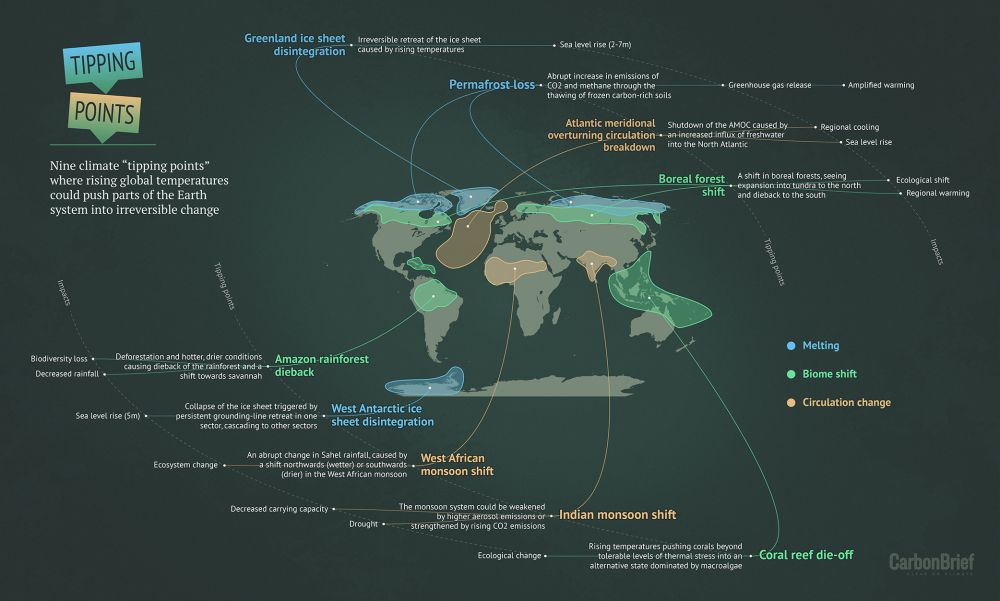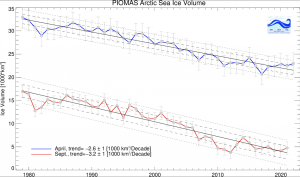Global ecological tipping point: Difference between revisions
From BurnZero
No edit summary |
mNo edit summary |
||
| (5 intermediate revisions by the same user not shown) | |||
| Line 1: | Line 1: | ||
Past these tipping points, scientists recon there is no way back<ref>https://illuminem.com/energyvoices/80df1713-3292-4626-911f-48decadc37ae?fbclid=IwAR1mTkC2LAoJy92kIninjXbu0ULxIOLGqymTzD7tbxfnENdlDBuqKjn-0bA</ref>: | '''Past these tipping points, we face societal [[collapse]], after which many scientists recon there is no way back<ref>https://illuminem.com/energyvoices/80df1713-3292-4626-911f-48decadc37ae?fbclid=IwAR1mTkC2LAoJy92kIninjXbu0ULxIOLGqymTzD7tbxfnENdlDBuqKjn-0bA</ref>:''' | ||
[[File:Ecological-tipping- | [[File:Ecological-tipping-points2.jpg|alt=Ecological-tipping-points|center|1000x1000px|Ecological-tipping-points]] | ||
*[[File:Blue Ocean Event (BOE).png|alt=Blue Ocean Event (BOE)|thumb|Figure 1. The decline of Arctic Ice which may lead to Blue Ocean Event (BOE).]]'''The Arctic''': this is the biggest worry of all the tipping points. If the ice melts, we will see the weather and warming related problems exacerbate as the ocean begins to heat up the planet even more (the albedo effect). Once that happens, we will likely see the jet stream lose its energy due to a lessening of temp difference between the Arctic and tropical region. Storms that form near mid-latitudes will get stuck in place or drift along slowly without the jet stream to push them along. Some areas will get excess rainfall - so much excess it kills crops. Others will experience extreme heat waves and droughts as the lack of jet stream will keep heat domes in place.the average temperature of the Arctic has increased 2.3°C since the 1970s. | |||
*'''The Arctic''': the average temperature of the Arctic has increased 2.3°C since the 1970s | |||
*'''West Antarctic sea ice''': we could lose this within ten years, and if so, sea levels will eventually rise three metres because of it. | *'''West Antarctic sea ice''': we could lose this within ten years, and if so, sea levels will eventually rise three metres because of it. | ||
*'''Amazon Rainforest''': the current projection is that we have five to ten years before the rainforest tips into a new state, that of a savannah. | *'''Amazon Rainforest''': the current projection is that we have five to ten years before the rainforest tips into a new state, that of a savannah. | ||
*'''Greenland ice sheet''': we could lose this in 20 to 25 years, and if so, sea levels will eventually rise seven metres because of it. | *'''Greenland ice sheet''': we could lose this in 20 to 25 years, and if so, sea levels will eventually rise seven metres because of it. | ||
'''References''' | '''References''' | ||
Latest revision as of 06:15, 17 August 2022
Past these tipping points, we face societal collapse, after which many scientists recon there is no way back[1]:
- The Arctic: this is the biggest worry of all the tipping points. If the ice melts, we will see the weather and warming related problems exacerbate as the ocean begins to heat up the planet even more (the albedo effect). Once that happens, we will likely see the jet stream lose its energy due to a lessening of temp difference between the Arctic and tropical region. Storms that form near mid-latitudes will get stuck in place or drift along slowly without the jet stream to push them along. Some areas will get excess rainfall - so much excess it kills crops. Others will experience extreme heat waves and droughts as the lack of jet stream will keep heat domes in place.the average temperature of the Arctic has increased 2.3°C since the 1970s.
- West Antarctic sea ice: we could lose this within ten years, and if so, sea levels will eventually rise three metres because of it.
- Amazon Rainforest: the current projection is that we have five to ten years before the rainforest tips into a new state, that of a savannah.
- Greenland ice sheet: we could lose this in 20 to 25 years, and if so, sea levels will eventually rise seven metres because of it.
References

